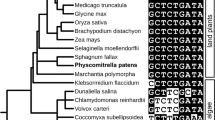Abstract
The moss, Physcomitrella patens, is a novel tool in plant functional genomics due to its exceptionally high gene targeting efficiency that is so far unique for plants. To determine if this high gene targeting efficiency is exclusive to P. patens or if it is a common feature to mosses, we estimated gene-targeting efficiency in another moss, Ceratodon purpureus. We transformed both mosses with replacement vectors corresponding to the adenine phosphoribosyl transferase (APT) reporter gene. We achieved a gene targeting efficiency of 20.8% for P. patens and 1.05% for C. purpureus. Our findings support the hypothesis that efficient gene targeting could be a general mechanism of Bryophyte transformation.



Similar content being viewed by others
References
Ashton NW, Cove DJ (1977) The isolation and preliminary characterisation of auxotrophic and analogue resistant mutants of the moss, Physcomitrella patens. Mol General Genet 154:87–95
Ashton NW, Champagne CEM, Weiler T, Verkoczy LK (2000) The bryophyte Physcomitrella patens replicates extrachromosomal transgenic elements. New Phytol 146:391–402
Asthon NW, Grimsley N, Cove DJ (1979) Analysis of gametopytic development in the moss, Physcomitrella patens, using auxin and cytokinn resistants mutants. Planta 144:427–435
Brücker G, Mittmann F, Hartmann E, Lamparter T (2005) Targeted site-directed mutagenesis of a heme oxygenase locus by gene replacement in the moss Ceratodon purpureus. Planta 220:864–874
Cove DJ, Knight CD, Lamparter T (1997) Mosses as model systems. Trends Plant Sci 2:99–105
de Boer JG, Glickman BW (1991) Mutational analysis of the structure and function of the adenine phosphoribosyltransferase enzyme of Chinese hamster. J Mol Biol 221:163–174
Edwards K, Johnstone C, Thompson C (1991) A simple and rapid method for the preparation of plant genomic DNA for PCR analysis. Nucleic Acids Res 19:1349
Gaillard C, Moffatt BA, Blacker M, Laloue M (1998) Male sterility associated with APRT deficiency in Arabidopsis thaliana results from a mutation in the gene APT1. Mol Gen Genet 257:348–353
Hanin M, Paszkowski J (2003) Plant genome modification by homologous recombination. Curr Opin Plant Biol 6:157–162
Hara K, Morita M, Takahashi R, Sugita M, Kato S, Aoki S (2001) Characterization of two genes, Sig1 and Sig2, encoding distinct plastid sigma factors(1) in the moss Physcomitrella patens: phylogenetic relationships to plastid sigma factors in higher plants. FEBS Lett 499:87–91
Hartmann E, Klingenberg B, Bauer L (1983) Phytochrome mediated phototropism in protonemata of the moss Ceratodon purpureus BRID. Photochem Photobiol 38:599–603
Houba-Herin N, Reynolds S, Schaefer D, von Schwartzenberg K, Laloue M (1997) Molecular characterisation of homologous recombination events in the moss Physcomitrella patens. In: Peth JC, Latché A, Bouzayen M (eds) 3e Colloque Général de la Société Française de Physiologie Végétale. SFPV-INRA, Toulouse, pp 22–23
Liu YG, Mitsukawa N, Oosumi T, Whittier RF (1995) Efficient isolation and mapping of Arabidopsis thaliana T-DNA insert junctions by thermal asymmetric interlaced PCR. Plant J 8:457–463
Nishiyama T, Fujita T, Shin IT, Seki M, Nishide H, Uchiyama I, Kamiya A, Carninci P, Hayashizaki Y, Shinozaki K, Kohara Y, Hasebe M (2003) Comparative genomics of Physcomitrella patens gametophytic transcriptome and Arabidopsis thaliana: implication for land plant evolution. Proc Natl Acad Sci USA 100:8007–8012
Paszkowski J, Baur M, Bogucki A, Potrykus I (1988) Gene targeting in plants. Embo J 7:4021–4026
Puchta H (2003) Towards the ideal GMP: homologous recombination and marker gene excision. J Plant Physiol 160:743–754
Quatrano RS, McDaniel SF, Khandelwal A, Perroud PF, Cove DJ (2007) Physcomitrella patens: mosses enter the genomic age. Curr Opin Plant Biol 10:182–189
Rose TM, Henikoff JG, Henikoff S (2003) CODEHOP (COnsensus-DEgenerate Hybrid Oligonucleotide Primer) PCR primer design. Nucleic Acids Res 31:3763–3766
Schaefer D (2001) Gene targeting in Physcomitrella patens. Curr Opin Plant Biol 4:143–150
Schaefer D (2002) A new moss genetics: targeted mutagenesis in Physcomitrella patens. Annu Rev Plant Biol 53:477–501
Schaefer DG, Zrÿd JP (1997) Efficient gene targeting in the moss Physcomitrella patens. Plant J 11:1195–1206
Shaked H, Melamed-Bessudo C, Levy AA (2005) High-frequency gene targeting in Arabidopsis plants expressing the yeast RAD54 gene. Proc Natl Acad Sci USA 102:12265–12269
Trouiller B, Schaefer DG, Charlot F, Nogue F (2006) MSH2 is essential for the preservation of genome integrity and prevents homeologous recombination in the moss Physcomitrella patens. Nucleic Acids Res 34:232–242
Vitt DH (ed) (2004) Classification of the Bryopsida. The hattori Botanical Laboratory, Nichina
Acknowledgements
We thank Dr. Michel Laloue (INRA Versailles, France) for providing the 2-fluoroadenine and the Ceratodon strain. BT was supported by grant from the Institut National de la Recherche Agronomique and Cellectis SA (Romainville France).
Author information
Authors and Affiliations
Corresponding author
Rights and permissions
About this article
Cite this article
Trouiller, B., Charlot, F., Choinard, S. et al. Comparison of gene targeting efficiencies in two mosses suggests that it is a conserved feature of Bryophyte transformation. Biotechnol Lett 29, 1591–1598 (2007). https://doi.org/10.1007/s10529-007-9423-5
Received:
Accepted:
Published:
Issue Date:
DOI: https://doi.org/10.1007/s10529-007-9423-5




